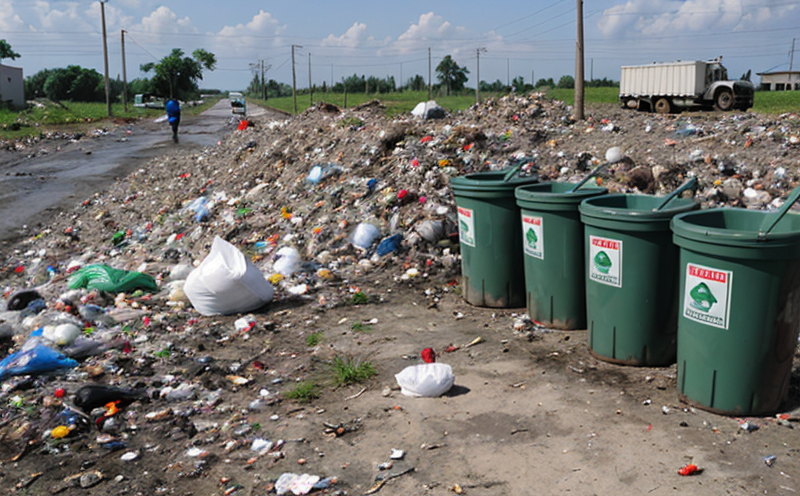EPA 1316 Parallel Batch Leaching Test in Solid Waste
The EPA 1316 Parallel Batch Leaching Test is a comprehensive method used to assess the leachate potential of solid waste materials. This test evaluates how hazardous substances, including metals and organic compounds, are released from solid waste under controlled conditions that simulate real-world scenarios. Understanding this release is crucial for environmental protection and ensuring compliance with regulatory standards.
The EPA 1316 test method is particularly important in the context of managing hazardous waste to prevent contamination of soil and groundwater resources. By quantifying leachate, facilities can implement appropriate mitigation strategies and ensure they are meeting stringent legal requirements set by environmental protection agencies.
During the testing process, samples are placed into a leaching solution that mimics conditions found in landfill environments such as temperature, pH, and microbial activity. The test allows for parallel batch testing where multiple specimens can be analyzed simultaneously under consistent conditions. This approach ensures more accurate and reliable results compared to single specimen tests.
The methodology involves several critical steps including sample preparation, leachate extraction, filtration, and analysis. Specimens are prepared by weighing out a representative portion of the solid waste followed by immersion in a defined volume of leaching solution. Samples are then incubated for specified periods before being filtered to collect leachate which is subsequently analyzed for various contaminants.
The EPA 1316 test provides valuable data on potential hazards posed by different types of solid waste materials such as construction debris, industrial sludges, and municipal refuse. Results from this testing can inform decisions regarding proper disposal methods, landfill design, and remediation efforts aimed at protecting natural environments.
Given its importance in environmental protection, it's essential to select a reputable laboratory capable of performing the EPA 1316 test accurately and consistently. Our team uses state-of-the-art equipment and follows strict protocols to ensure reliable results every time. Whether you're conducting research or seeking compliance verification, our expertise ensures that your needs are met effectively.
- Parallel batch testing allows for simultaneous evaluation of multiple samples under identical conditions.
- Comprehensive analysis includes measurement of metals like lead, cadmium, and arsenic as well as organic compounds such as polycyclic aromatic hydrocarbons (PAHs).
- The test helps identify potential risks associated with specific types of solid waste materials which aids in informed decision-making processes.
Why It Matters
The EPA 1316 Parallel Batch Leaching Test plays a pivotal role in safeguarding public health and the environment. By accurately assessing leachate potential from solid waste, this test enables organizations to take proactive steps towards preventing contamination of soil and water bodies.
Compliance with environmental regulations is mandatory for many industries dealing with hazardous materials. The results obtained through EPA 1316 testing provide critical information that helps facilities meet these requirements effectively. Furthermore, understanding the leachate characteristics allows for better planning of waste management practices which can lead to long-term cost savings and improved operational efficiency.
For research purposes, this test offers insights into how various factors influence leaching rates such as temperature variations or microbial activity levels within different types of solid waste. This knowledge contributes significantly to advancing scientific understanding in fields related to environmental science and engineering.
Applied Standards
The EPA 1316 Parallel Batch Leaching Test adheres closely to the guidelines set forth by the Environmental Protection Agency (EPA). Specifically, it aligns with the requirements outlined in EPA Method 1316. This standard provides detailed instructions on sample preparation, leaching procedures, and analytical techniques necessary for conducting accurate parallel batch tests.
Additionally, the test incorporates aspects of other relevant standards such as ISO 15094 which pertains to solid waste characterization. These international standards ensure consistency across laboratories performing similar analyses worldwide.
Industry Applications
- Hazardous Waste Management: Evaluates the leachate potential of hazardous wastes to inform disposal methods and landfill design.
- Municipal Solid Waste: Assists in assessing the environmental impact of municipal refuse on landfills and surrounding areas.
- Industrial Sludges: Helps determine the leachate characteristics of industrial byproducts to ensure safe handling and disposal practices.
- Construction Debris: Provides insight into potential contamination risks associated with construction site waste materials.





